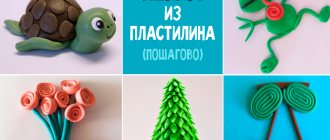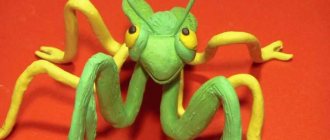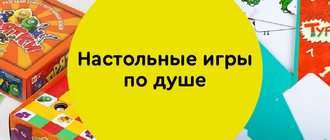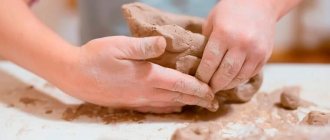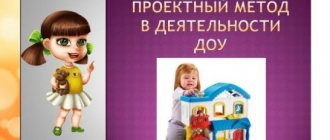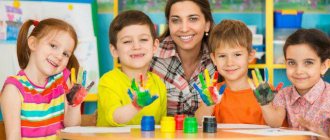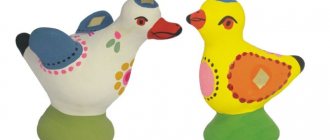"Traditional and non-traditional modeling techniques"
Traditional and non-traditional modeling techniques.
Compiled by: teacher of MBDOU "DSOV No. 39"
According to the Federal State Educational Standards program for the educational field "Artistic and Aesthetic Development", the main task is aimed at developing in children an aesthetic attitude to the world, the accumulation of aesthetic ideas and images, the development of aesthetic taste, artistic abilities, and the development of various types of artistic activities. One of the directions of this educational field is “artistic creativity”. The main goal is to teach children to create creative works through various types of artistic and productive activities.
The more diverse children's activities are, the more successful the child's diversified development is, his potential capabilities and first manifestations of creativity are realized. In traditional pedagogy, drawing, modeling, and design are called productive activities; children create a “product” - a drawing, an appliqué, a mini-sculpture. Let's focus our attention on this type of activity as modeling.
Modeling is the most tangible form of artistic creativity. The child not only sees what he created, but also touches it, picks it up and changes it as necessary. In modeling, the scale of crafts is not determined by the format of the sheet, as in drawing and appliqué, or the size of the cubes, as in construction. It depends each time only on the child’s plan, on his skill and individual characteristics. In modeling, creative tendencies and abilities are realized even with a minimum of materials. From one lump of plasticine you can create an infinite number of images, each time finding new options and methods, even without the participation of a teacher and parent.
Modeling is a type of artistic activity that has many aspects. Based on content and theme, they distinguish between plot, subject, decorative and complex modeling.
In story modeling, children convey story compositions in which individual images are connected in one way or another: by meaning, by placement in space, by proportions, by dynamics, etc. In object modeling, children sculpt individual specific images. In decorative modeling, children create decorative items. In complex modeling, children arbitrarily or to solve a given artistic problem combine different methods of modeling.
According to the method of creating an image, the following types of modeling are distinguished: from memory, from idea, from design, from life, from a diagram, from a drawing, from a verbal description.
According to the way children are organized and the nature of their activities, modeling can be: individual, collective - in co-creation with adults or peers, complex (integrated), when modeling is combined with other types of artistic and cognitive activities, as well as with various games.
You can sculpt from carved plastic, environmentally friendly materials that are easy to handle, acquire the intended shape during the sculpting process and retain it for at least some time. These are clay, plasticine, dough, snow, wet sand, paper pulp.
Clay is the most plastic natural material suitable for modeling. It is elastic, neutral in color, which is important for the perception of shape. Old clay crafts can be reused. To do this, they need to be crushed, filled with water, etc. The suitability of clay for modeling is checked as follows: a small piece of clay is kneaded, rolled into a “sausage” and rolled into a ring. If the ring is cracked, it means the clay is dry and needs to be sprinkled with water or a little vegetable oil added. If the clay is too wet, you can leave it in the air for a while to allow some of the water to evaporate. The fashioned crafts are dried, fired, and then primed and decorated with paints.
Plasticine is an artificial material specially created for modeling and modeling. Plasticine is not as flexible as clay, but it has its advantages. A large selection of colors makes it possible to create multi-colored crafts and compositions.
Dough is another accessible material that is easy and enjoyable to sculpt with. And the dough is easy to wash off by hand. Crafts made from salt dough look like real masterpieces. But crafts made from salt dough need to be dried for a very long time and well. They can be varnished and stored for many, many years.
Children's creative work largely depends on the chosen modeling method. With the constructive sculpting method, the image is created from separate parts, like parts of a construction set (hence the name).
The sculptural method is sometimes also called plastic or sculpting from a whole piece. Sculptural is a more complex method of sculpting compared to constructive. Children usually need some explanation and demonstration of the technique.
The combined method combines two methods: constructive and sculptural. It allows you to combine the features of modeling from a whole piece and from individual parts.
Crafts made using the relief method represent a three-dimensional molded image on a plane. There are the following types of relief: bas-relief, high relief, counter-relief.
Work done in a modular manner is reminiscent of putting together a three-dimensional mosaic or constructing from identical parts. Another original way of sculpting is sculpting from rings. This method was used by folk craftsmen - potters.
Modeling from plates. Using this rarely used method, you can rationally, economically and fairly quickly create voluminous, hollow crafts. And modeling on the form. When, for example, plasticine is rolled out in an even layer, it is wrapped around the mold, the excess is cut off, the edges are joined and the seam is smoothed. Decorate with moldings or cut-out patterns.
The use of additional materials and tools depends on the material from which the work will be performed. This is a modeling board; stacks – wooden or plastic; napkins – paper and fabric; a bowl of water for wetting your fingers and napkins when sculpting with clay. Natural materials: shells, pebbles of different shapes and colors, leaves, fruits, branches, seeds, feathers. Factory produced stamps. Household items that give an imprint or imprint (corks, felt-tip pen caps, etc.). Cardboard, boxes, jars, lids, straws (cocktail), beads, buttons. Molds for dough or for playing with sand.
The most popular material used by teachers when working with children is plasticine. Modeling with plasticine is a type of art that is available for classes in kindergarten and school, as well as in club work and in the family. This material also arouses great interest among children. Using an unconventional technique for working with plasticine - plasticineography.
The concept of “plasticineography” has two semantic roots: “graphite” means to create, draw, and the first half of the word “plasticine” implies the material with which the plan is executed.
Plasticineography is a new type of decorative and applied art. It is the creation of stucco paintings depicting more or less convex, semi-volume objects on a horizontal surface. The main material is plasticine. It is possible to use combined techniques. For example, decorating the surface with beads, plant seeds, and natural materials. In some cases, using the plasticineography technique, a product is modified, which leads to the creation of original works. For example, a landscape is graphically depicted on a flat surface, and foreground details are depicted using plasticineography.
By doing plasticineography, general and fine motor skills of the hands develop, which in turn is one of the main stimulators of a child’s brain activity. The better the baby works with his fingers, the better he develops, the better he speaks and thinks.
Plasticineography makes it possible to solve not only practical problems, but also educational ones, which in general allows for the comprehensive development of a child’s personality. Children not only gain knowledge, skills, and abilities, but also at the same time consolidate the information received in direct educational activities in all educational areas of the “From Birth to School” program.
During plasticineography classes, children develop mental processes: attention, memory, imagination, thinking, perception, spatial orientation, sensorimotor coordination, that is, those significant functions that are necessary for successful learning at school, as well as creativity. Children learn to plan their work and complete it. Children are taught a culture of communication, norms of behavior, cognitive interest, independence, self-confidence, individuality, initiative, and the ability to work in co-creation.
“Plasticine” painting can rightfully be considered as a unique technique in modeling. Children are delighted to discover and create new colors and shades on their own. This enriches and diversifies the palette of plasticine, bringing modeling closer to painting. Conventionally, two methods can be distinguished: incomplete and complete mixing of pieces of plasticine of different colors in one lump. When different colors are not completely mixed, the result is a “marbled” color. When different colors are completely mixed, new colors or shades are obtained. It is necessary to show children a rational mixing technique: pinch off or cut pieces of the desired color, roll a piece of each color into a roller, connect the rollers and roll into one roller, fold this roller in half and roll out again, fold and roll out again. This operation must be continued until a uniform color is obtained. But first you can experiment with watercolor paints. This will help you learn that when mixed, yellow and red produce orange, blue and yellow produce green, and red and blue produce violet. Experience with gouache clearly shows that white helps create a whole range of shades of any color. You just have to change the proportions. The more white, the softer and lighter the color.
The advantage of plasticineography over sculpting three-dimensional figures is that a very beautiful and vivid plot can be created on a plane, and much less material will be needed.
When working with plasticine, a number of difficulties may arise:
plasticine that sits for a long time becomes hard, it is difficult to knead it and prepare it for work, especially with children’s fingers;
Plasticine contains fatty components, so greasy stains appear on paper or other bases over time.
All these troubles can be avoided if you follow the following recommendations;
Warm up hard plasticine before direct educational activities.
When working with plasticine, you should use thick cardboard as a base, not thin sheets of paper, so that it does not deform when performing techniques of pressing, smearing, smoothing,
flattening while securing an object to a horizontal surface. It is better to use varnished cardboard.
To ensure that the picture does not lose its attractiveness over time, the base with or without a pre-drawn outline should be covered with tape. This will help avoid the appearance of greasy stains. It is easier to work on a slippery surface and using a stack it is easier to remove excess plasticine without leaving marks. The contours in this case are made with a regular felt-tip pen, which can also be easily erased with a damp cloth if the child suddenly makes a mistake in depicting the object. If it is not possible to cover the base with tape, the outline is drawn with a simple pencil.
If the work is performed as a gift or to decorate a group room, it is recommended to cover the surface of the composition made of plasticine with colorless varnish. The plasticine under the varnish film hardens over time, the product becomes more durable and retains its brightness, and it is easier to remove dust from the varnished surface.
There must be a cloth wet napkin for hands on the child’s desk so that he can use it at any time, and after completing the work, first wipe his hands with a napkin and then wash them with soap and water.
Working with plasticine requires physical effort, so in the process of doing it, children need rest in the form of physical education and warm-ups. When carrying out direct educational activities, it is important that it contains not only educational information, but is also full of games, physical education, finger gymnastics, game situations,
Plasticineography should be taught in order of increasing complexity: it is better to start with simple, small-sized images and gradually move on to creating more complex ones. By making plasticine images, children gradually master the techniques of “drawing” with plasticine, namely: pinching, rolling, unrolling, flattening, sticking, pressing, smearing, pressing, smearing, smearing. All types of plasticine printing are successfully used: direct, stained glass, contour, multilayer, modular, mosaic, textured. Children will gradually learn to create interesting thematic pictures with their own hands, which they can give to their loved ones and friends. If you successfully master the technique of drawing with plasticine, you can perform group work.
You can store children's masterpieces made on cardboard in regular files, stapled in a folder. Can be beautifully framed.
Bibliography
From birth to school. Approximate general education program
preschool education framework /
Edited by N.E. Veraksy, T.S. Komarova, M.A. Vasilyeva. – M.: MOZAYKA-SYNTHESIS, 2014. – 368 p.
Lykova I.A. We sculpt, we fantasize, we play. – OOOTC “Sfera”, 2000.
Davydova G.N. Plasticineography. Animal painting. LLC Publishing House "Scriptorium 2003", 2008.
Smirnova T.V. Artistic and aesthetic development of children 5-6 years old. Plasticineography classes. Publishing house "Teacher", Volgograd, 2014,
Husky
You will need: plasticine of gray, white, black, blue, red and yellow, toothpick, stacks.
Master Class
- Roll a ball of gray plasticine.
- Stack 2 triangles at the top of the ball.
- Attach 2 flat triangles of white plasticine.
- Cover the bottom of the ball with white plasticine.
- Roll out an oblong oval from white plasticine and attach it as a muzzle.
- Roll the nose out of black plasticine and attach it to the muzzle.
- Make eyes from blue, black and white plasticine and attach them to white triangles.
- Make a tongue out of red plasticine and secure it.
- Make the lower part of the mouth from white plasticine and attach it under the tongue.
- Make 2 triangles from gray plasticine and attach them as ears.
- Work out the features of the muzzle with a stack.
- Make a body out of gray plasticine, insert a toothpick and secure the head.
- Cover the dog's belly with white plasticine.
- Roll 2 sausages from gray plasticine and attach them as front legs.
- Make 4 white plasticine cakes and attach them to the paws as shown in the image.
- Roll a sausage out of gray plasticine and mold a crescent-shaped tail.
- Stack the ponytail, adding fluffiness, then attach it.
- Make a collar from blue plasticine, and make a clasp from yellow plasticine, then make holes with a toothpick.
- Draw the ears, muzzle and paws with a stack.
Plasticine husky is ready!
Salty dough
This type of creativity was held in high esteem by our distant ancestors, who decorated pies and loaves with figures, braided ears of corn and berries. Even the smallest children can use the dough; the main advantage of this material is that it is completely safe and environmentally friendly.
You can prepare materials for crafts like this:
- take a glass of flour and salt, add ½ glass of very cold water, knead thoroughly until a homogeneous mass is formed;
- to the three previously described components add 2 tablespoons of sunflower oil or fatty glycerin cream.
You can knead the dough either by hand or with a mixer. The first option is suitable for creating small elements and details, while the second is ideal for larger-scale sculpting.
If a child has been modeling for a long time and has succeeded in this matter, you can prepare an improved version of the dough for him, which allows him to create more durable crafts and paint them. For this you will need:
- flour - 1.5 cups;
- salt (fine extra) – 1 glass;
- water – ½ cup;
- PVA or wallpaper glue - 2-3 tablespoons (can be done without glue).
This option allows you to create both large parts and small elements.
Chamomile
You will need: white, yellow and green plasticine, stacks, boule, skewer.
Master Class
- Make a drop of white plasticine, then flatten it into a petal shape.
- Draw a stack of lines.
- Make 20 white petals.
- Roll up the yellow center of the flower.
- Prepare a strip of yellow plasticine and cut through the fringe.
- Stick a strip around the circle of the yellow center.
- Stick the white petals in a circle, placing them in a checkerboard pattern.
- Cover the skewer with green plasticine, leaving the tip free.
- Make a cake from green plasticine and sculpt a receptacle.
- Stick the bud to the receptacle.
- Draw a mesh texture on the yellow center.
- Make a leaf, draw the texture and stick it to the stem.
The plasticine chamomile is ready!
Pendant "Snowman"
You will need: a sheet of cardboard, a simple pencil, scissors, string, tape, plasticine in white, orange, brown, black, blue, purple and green, skewer, stack.
Master Class
- Draw a circle on a piece of cardboard, then cut it out.
- Cover one side of the circle with white plasticine.
- Make oval legs from purple plasticine, then attach them to the bottom of the circle.
- Roll out an oval nose from orange plasticine, then attach it.
- Make eyes and a smile for the snowman from black plasticine.
- Roll 2 buttons from blue plasticine, attach them and use a skewer to make 2 holes in the buttons.
- Roll the purple and blue plasticine into sausages, then form a hat as shown in the image.
- Roll a ball of white plasticine and attach it as a pompom, then use a skewer to create a “fluffy” texture.
- Make stick handles from brown plasticine, then attach them to different sides of the circle.
- Make highlights on the nose and eyes from white plasticine.
- Draw a knitted pattern onto the hat using a skewer.
- Draw lines on the legs as shown in the image.
- Make 3 leaves from green plasticine and roll 3 orange berries, then decorate the hat.
- Attach the string to the back using tape.
The plasticine “Snowman” pendant is ready!
Apple
You will need: red, green, black, white and brown plasticine, stacks, toothpick.
Master Class
- Roll out a ball of red plasticine.
- Shape the ball into an apple shape.
- Prepare a strip of brown plasticine and cut fine fringe.
- Make a small indentation in the apple for the stamens.
- Cut a small piece of the stamens, twist them and attach them to the apple.
- Make a stalk out of brown plasticine as shown in the image.
- Make a small indentation in the apple and stick the stem.
- Make 2 leaves from green plasticine and draw lines using a stack and a toothpick.
- Stick the leaves to the base of the cutting, then give them a curved shape.
- Make a droplet of white plasticine, flatten it and stick it to the apple as a highlight.
- Roll 5 balls of green plasticine and form a caterpillar.
- Roll 2 very small balls of black plasticine and stick them on as the caterpillar's eyes.
- Stick the caterpillar to the apple.
The plasticine apple is ready!
A pineapple
You will need: yellow, green, dark green and any color plasticine, stack, toothpick.
Master Class
- Roll a ball of brown plasticine (you can use leftover plasticine of any color for the base).
- Give the ball a pear shape and make the base stable.
- Roll out a ball of dark green plasticine, then roll it into an oval shape.
- Make a larger cake from yellow plasticine.
- Combine the green and yellow cakes, then roll them out.
- Turn the workpiece over with the yellow side up and draw a grid with a stack.
- Wrap the brown pineapple with a yellow tortilla.
- Trim off excess plasticine and smooth the joints with your fingers.
- Make oblong leaves from green plasticine and cut out the jagged outline.
- Stick the leaves to the top of the pineapple as shown in the image.
Plasticine pineapple is ready! Also check out the champagne and candy pineapple.
Panda
You will need: black, white and green plasticine, toothpicks, stacks.
Master Class
- Roll a ball of white plasticine.
- Push through two holes for the eyes.
- Roll balls of black plasticine, then attach and flatten them.
- Roll out a flat oval of white plasticine and attach it to the bottom of the head.
- Attach the black spout.
- Make eyes from white, green and black plasticine, then attach them.
- Make black ears and attach them to the top of the head.
- Roll out a roll of black plasticine, flatten it in the center and bend the ends.
- Roll a ball of white plasticine and glue it to the black blank.
- Connect the workpiece and the head using a toothpick.
- Mold and attach the black lower legs.
- Roll balls of white plasticine and attach them as pads to the paws.
- Draw in eyebrows with a toothpick.
- Roll a ball of black plasticine and attach it in place of the tail.
- Make a bamboo stick from green plate and attach it to the panda’s body.
The plasticine panda is ready! I recommend watching this video!
We sculpt Smesharik Krosh from plasticine. Cartoon. Kikoriki made of plasticine.
Grape
You will need: purple, brown and green plasticine, glass stack, thin wire.
Master Class
- Make a rope from purple plasticine.
- Cut it into pieces.
- Roll each piece into balls.
- Make a cone out of purple plasticine.
- Cover the cone with grapes, leaving the top part free.
- Prepare a piece of thin wire and cover it with brown plasticine, as shown in the image.
- Draw the lines to create a branchy texture.
- Attach a wire twig to the top of the grape, then stick the grapes around it.
- Make a cake from green plasticine.
- Outline the outline of the leaf and cut it out, then draw the texture.
- Roll out a thin strip of green plasticine, carefully twist it and stick it to the grapes.
Plasticine grapes are ready! I recommend watching this video!
Air plasticine for children, learning to sculpt roses
Clay
Experts recommend using this material without fail, even in parallel with plasticine, since the clay is not colored and does not distract attention directly from the form. This pliable and soft material allows you to create a variety of figures, including dishes, people, and animals. Then they can be painted in bright colors to create an unusual composition. The key advantage of the material, which distinguishes it favorably from plasticine, is the ability to store the craft for a long time.
Next, we will consider several clay options for children's creativity.
Polymer
Sold in almost every art supply store, it is affordable, pliable, but becomes hard after baking. Available in a variety of colors, including bright ones, to suit your baby’s taste. No preliminary preparation is required - the material is already ready for use, all that remains is to sit down and start sculpting.
Please note that children should not be given the opportunity to work with clay unattended, since very few children will be able to avoid the temptation to put the bright substance in their mouth.
Natural
The first advantage is the absence of impurities and dyes. This is an environmentally friendly product, packaged in bags. And this is also its main drawback - the clay will need to be kneaded before work. Most often, ordinary gray clay is used, a soft and plastic material.
Not every child will be delighted with this natural material - polymer colorful options, as a rule, are liked much more by young sculptors. But this is everyone’s personal choice; someone may like the opportunity to first sculpt a figurine and then decorate it.
